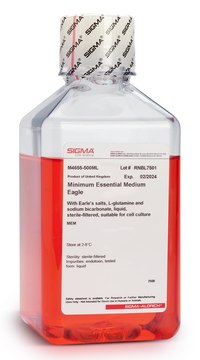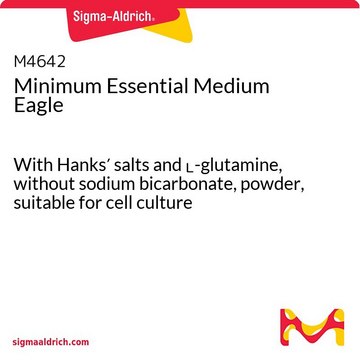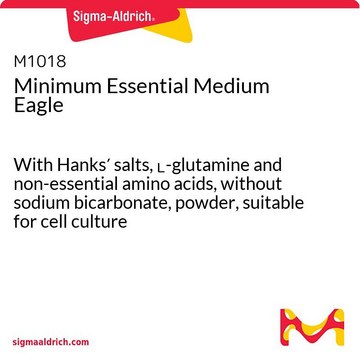M2414
Terreno essenziale minimo di Eagle
With Earle′s salts and reduced NaHCO₃. without ʟ-glutamine, liquid, sterile-filtered, suitable for cell culture
Sinonimo/i:
MEM
About This Item
Prodotti consigliati
product name
Terreno essenziale minimo di Eagle, Modified, with Earle′s salts and reduced NaHCO3. without L-glutamine, liquid, sterile-filtered, suitable for cell culture
Livello qualitativo
Sterilità
sterile-filtered
Forma fisica
liquid
tecniche
cell culture | mammalian: suitable
Impurezze
endotoxin, tested
Componenti
phenol red: 0.011 g/L
NaHCO3: 0.85 g/L
glucose: 1.0 g/L
L-glutamine: no
Condizioni di spedizione
ambient
Temperatura di conservazione
2-8°C
Cerchi prodotti simili? Visita Guida al confronto tra prodotti
Descrizione generale
MEM, which incorporates these modifications, includes higher concentrations of amino acids so the medium more closely approximates the protein composition of cultured mammalian cells. MEM has been used for cultivation of a wide variety of cells grown in monolayers. Optional supplementation of non-essential amino acids to the formulations that incorporate either Hanks′ or Earle′s salts has broadened the usefulness of this medium.
Applicazioni
Altre note
Ricostituzione
Comunemente ordinati con questo prodotto
Supplemento
Codice della classe di stoccaggio
12 - Non Combustible Liquids
Classe di pericolosità dell'acqua (WGK)
WGK 1
Punto d’infiammabilità (°F)
Not applicable
Punto d’infiammabilità (°C)
Not applicable
Certificati d'analisi (COA)
Cerca il Certificati d'analisi (COA) digitando il numero di lotto/batch corrispondente. I numeri di lotto o di batch sono stampati sull'etichetta dei prodotti dopo la parola ‘Lotto’ o ‘Batch’.
Possiedi già questo prodotto?
I documenti relativi ai prodotti acquistati recentemente sono disponibili nell’Archivio dei documenti.
I clienti hanno visto anche
Il team dei nostri ricercatori vanta grande esperienza in tutte le aree della ricerca quali Life Science, scienza dei materiali, sintesi chimica, cromatografia, discipline analitiche, ecc..
Contatta l'Assistenza Tecnica.





